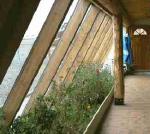Search engine visitors - click here to access entire "$ensible Home" web site
Click here to see a descriptive illustration of several designs of do-it-yourself sunroom/greenhouses.
Dear Jim: I want a sunroom for more living space, but I cannot afford to have one built. Are there any efficient do-it-yourself kits available that can help heat my home? Can I build one from scratch and what design is best? - Sandi T.

A: Adding a sunroom to a house is an excellent investment and often increases the resale value of your home more than its cost. The cost per square foot of floor space is much less than adding a traditional room to your home. Also, it is great recreational area for children. Even if it gets a little chilly during winter or overheats during summer, they won't mind much.
By designing and locating the sunroom properly, it can capture enough free solar heat to stay warm most of the year. It may also help heat the rest of your house during spring and fall so your heat pump or furnace does not have to run as much.
If helping to heat your house is a goal, include some provision to get the solar-heated air into your house. The simplest method is to just open a window between the house and sunroom when it is warmer than the house. Installing an exhaust fan (outlet into house) high on a sunroom wall is more effective. For the most convenience, install a thermostat to control the fan.
Also, make the sunroom large enough so you can have a small container garden in one corner for fresh green salads and herbs year-round. This also produces some moisture for the air which improves your family's comfort during winter and allows you to set the heating thermostat lower.
For just growing some plants and reasonably comfortable living space, any orientation from southeast to southwest is adequate to capture the sun's heat. Select a convenient location with easy access from inside your house, often at an existing exterior door opening.
However, if you plan to use the sunroom to help heat your house, an orientation to true solar south is important for the greatest solar heat gain. Depending upon where you live in the U.S., true solar south can vary substantially from compass south. Check with your local weather service or on the internet for the amount to adjust compass south to get true solar south for your area.
Most fancy sunrooms you see on homes are typically contractor installed, but not all. The contractors buy the long (20-feet or more) aluminum framing extrusions and cut them to size at the job site. I actually bought 20-foot lengths and cut them myself to build my own sunroom. It took me more than a month to build it. They told me a typical contractor builds one in just two days.
Some sunroom manufacturers will sell the components to homeowners in precut kit sizes. Do an internet search and contact sunroom manufacturers to see if they sell their products directly in kit form. If you are lucky, you may find a precut kit close to the size you need.
With some of do-it-yourself sunroom kits, you just have to build the base for the sunroom and assemble the components. Some frames are lightweight enough to be built over a wood deck. Often, you will find it less expensive to purchase the glass or plastic window panes locally.
If you are a do-it-yourselfer, you should be able to build an efficient sunroom from scratch. This offers the advantages of lower cost and building the precise size you need. You may find, due to the orientation of your house, topography or landscaping, an irregular shape may get better sun exposure. This can also be very attractive.
Before you begin to construct the 2x4 lumber framing, visit local home centers and building supply outlets. They often have custom-sized high-efficiency windows which a homeowner or builder did not end up buying. Look for ones with low-emissivity glass with argon gas in the gap. These are often sold at quite a discount. Once you have your windows, design the rest of the sunroom framing to fit them.
In warm climates, you should have a solid roof on the sunroom or it will likely overheat during summer. In average and cold climates, a clear roof captures more heat and you can control overheating with movable shades. Installing roof vents or a venting skylight also helps. Designs with slanted (lean-to) glass capture the most heat, but often have overheating problems. In warm climates, always install vertical glass.
For the best comfort and efficiency, add thermal mass to the sunroom. This reduces overheating and helps it hold heat when the sun goes down. A brick paver floor and a concrete block kneewall are effective mass. Use large planters with heavy clay pots.
Instant Download Update Bulletin No. 769 - do-it-yourself instructions, diagrams, and materials list for building an inexpensive sunroom/greenhouse and an A-frame portable cold frame, chart showing thermal storage capacity for several different materials, growth characteristics for 13 greenhouse vegetable/herb plants.
Dear Jim: I get tried of buying the deep black mulch each year for my garden. Also disposing of all of those bags does not seem good for the environment either. Is there any mulch with a longer life? - James G.
A: The dark hardwood mulch, called "black gold" in my part of the country, does degrade quickly. It is not bad for the soil when it degrades over winter, but all the bags and transportation are wasteful.
There is dark mulch (Rubberific) made from recycled old truck tires that would otherwise end up in a landfill. It should last at least ten years and is comfortable to walk on if you like to garden in your bare feet as I do.